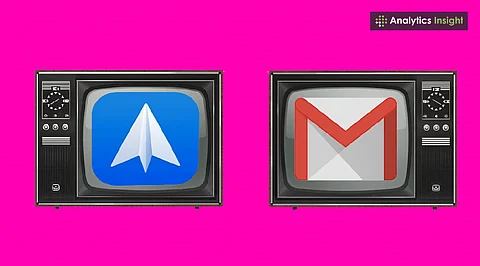

Smart Inbox Boosts Efficiency: Spark’s Smart Inbox categorizes emails automatically, letting users focus on important messages while reducing clutter and email fatigue.
Collaboration Made Easy: Real-time draft editing and task assignment in Spark transforms email into a productive workspace for teams and professionals.
Enhanced Productivity and Privacy: Unified accounts, customizable interface, and strong privacy features make Spark a secure, efficient, and user-friendly email solution.
Email remains an essential communication channel, whether work-related, school-related, or just a regular conversation. When it comes to Gmail vs Spark, Gmail has long dominated the space with its familiar interface, robust security, and seamless integration within Google Workspace.
However, newer clients like Spark are gaining ground, offering unique features designed to boost productivity and simplify inbox management. So, if you’ve been wondering whether to stick with Gmail or explore alternatives, here’s why Spark should be considered.
One of Spark's most critical offerings is its email smart inbox feature, designed to organize emails efficiently and prioritize important messages. Unlike Gmail, which organizes emails primarily via date and threading, Spark can do so automatically according to Personal, Notifications, and Newsletters.
This mechanism allows important emails to stay out of the way of promotions or less urgent messages. End-users can glance at the box without needing to read much of their inbox content and immediately consider emails that matter to them; this saves a lot of time while reducing email fatigue.
One of Spark's special features for team collaboration is the real-time collaboration feature for email drafts, just like Google Docs. Team members can set comments on the draft, suggest edits, and assign tasks from the email interface.
Gmail packs a punch for email, but you'd have to bring in third-party tools or add-ons for true collaboration. For professionals and teams, Spark transforms email into a productive workspace, rather than just a means of messaging.
One of the most common problems with Gmail is the email overload issue. Spark provides advanced customization for snooze and follow-up options, allowing you to snooze emails for later, set reminders, or track responses with a mailing tool. This way, significant messages are less likely to get overlooked.
Although Gmail has introduced features like reminders and snooze, its system is less efficient than Spark's, which offers smart priority suggestions and makes managing delayed emails much easier.
Also Read: How to Use Gmail for Your Business Email: A Simple Guide
Managing multiple Gmail email accounts can become cumbersome, especially when switching between them. Using this system, users achieve unified account management.
They can add multiple email addresses, such as Gmail, Yahoo, Outlook, or iCloud, to a single inbox. This setup acts as a single view into the workflow, reducing the friction of checking accounts one by one.
Its search functionality surpasses Gmail's basic search features, such as simple filters, smart suggestions, and natural language queries. Users can type questions like ‘emails from John last week’ and quickly find the relevant messages, saving valuable time.
Spark also offers more flexible folders and tags, enabling users to organize their inbox more efficiently than Gmail's traditional label system.
Privacy-conscious users will value Spark’s focus on security. Spark does not access email content or sell user data, unlike the free version of Gmail, which relies heavily on this data for targeted ads. Spark also provides encryption to protect sensitive conversations.
The Spark interface stays clean, minimalistic, and highly customizable. Users can personalize the layout, select themes for colors, and configure swipe gestures to match their workflow. With features like Quick Replies, email templates, scheduled sending, and more, Spark is designed to deliver efficient results while looking good.
Also Read: 10 Best Practices to Improve Email Deliverability
Email remains a reliable and full-featured communication platform, but Spark takes it further. As a productivity email app, Spark enhances inbox management with its stylish Smart Inbox, offers real-time collaboration tools, and boosts overall efficiency.
Its intuitive design, support for multiple unified accounts, and focus on teamwork make it ideal for professionals, teams, and individuals seeking a lighter, more organized inbox. Switching to Spark transforms email from a tedious task into a streamlined, satisfying, and productive experience.
Q1. What is Spark email and how is it different from Gmail?
Spark is a productivity-focused email client designed to organize your inbox efficiently. Unlike Gmail, it offers a Smart Inbox that categorizes emails, real-time collaborative drafting, customizable snooze options, and unified account management. Spark aims to enhance productivity, reduce email clutter, and streamline team communication in one interface.
Q2. Can I use Spark with multiple email accounts?
Yes, Spark allows users to connect multiple email accounts from Gmail, Yahoo, Outlook, and iCloud into a single unified inbox. This feature simplifies managing multiple addresses, eliminates the need to switch accounts frequently, and provides a consolidated view of all your emails, improving workflow efficiency and inbox organization.
Q3. How does Spark’s Smart Inbox improve productivity?
The Smart Inbox in Spark automatically categorizes emails into Personal, Notifications, and Newsletters. This ensures important messages are prioritized, while less urgent emails are separated. By highlighting what truly matters, users can quickly process emails, save time, reduce overload, and maintain focus, making daily email management faster and more efficient.
Q4. Is Spark safe and secure compared to Gmail?
Spark prioritizes user privacy and security. It does not read, scan, or sell your email data for advertising purposes. Additionally, Spark supports email encryption, keeping sensitive information protected. While Gmail provides strong security, its free version relies on data for personalized ads, making Spark a more privacy-conscious choice for users.
Q5. Can teams collaborate using Spark email?
Yes, Spark allows teams to collaborate in real time on email drafts. Users can comment, suggest edits, and assign tasks directly within the email interface. This eliminates the need for external tools, improves communication, and ensures everyone stays on the same page, making Spark particularly useful for professional and team workflows.
